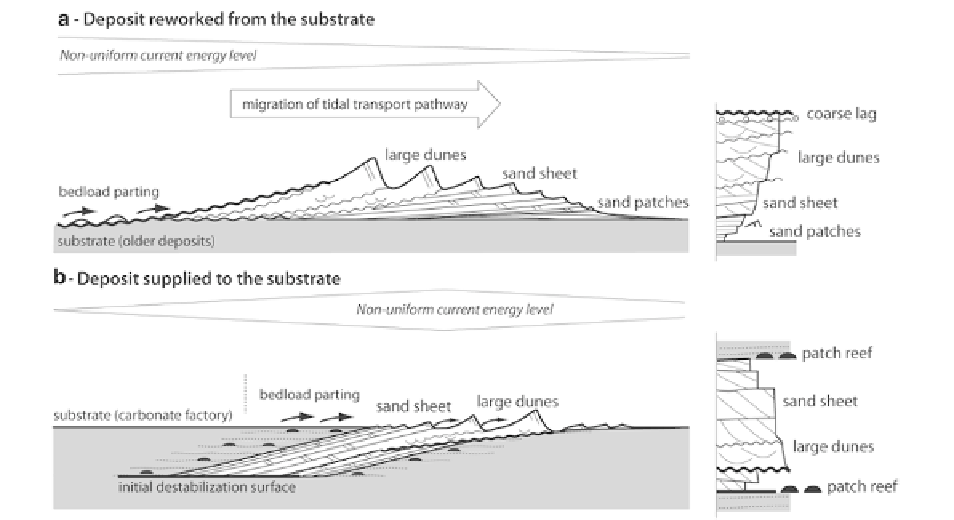Geology Reference
In-Depth Information
Fig. 13.19
Space-thickness diagrams showing the successions
created by a tidal-transport pathway in (
a
) a siliciclastic setting
where most sediments are reworked from older deposits and (
b
)
a carbonate environment with significant
in situ
production. Note
the difference with regard to where the deposit occurs relative
to the area of strongest currents. Progressive sediment starvation
in the siliciclastic setting and down-flow migration of facies
zones take place as the zone of seafloor erosion expands (cf.
Harris et al.
1995
), producing an upward-coarsening succession
topped by an erosional lag. The carbonate system, by contrast, is
not sediment starved and records a more symmectrical upward-
coarsening/upward-fining succession that forms as a result of
migration of the dune field over lower-energy deposits, followed
by gradual abandonment as tidal-current speeds decreases while
transgression proceeds. Patch reefs are inferred to occur in prox-
imity to the dune field in the carbonate example, because nutri-
ents are supplied by the tidal currents. Cross sections not to scale,
but sediment thicknesses can reach 30-50 m in both situations.
The horizontal extent is tens of kilometers. (Sketches based on
Belderson et al.
1982
and Anastas et al.
2006
, respectively)
separate cross beds, and horizontal burrows within the
deposits. For additional details on the ichnology of tidal
deposits, readers are referred to Chap. 4.
of longshore drift, coupled with erosional retreat
of the shoreline, creates a large headland-attached
sand body called a
shoal retreat massif
(Swift
1975
).
Similar sediment bodies also form seaward of river
mouths. As the transgression progresses and the shore-
line migrates landward, nearshore ridges become left
behind on the shelf where they can either become
moribund or continue to be reworked actively. Even
where the source deposit is muddy, the tidal currents
can winnow away the mud and produce a sandy
deposit, as illustrated by some ridges in the East China
Sea (Liu et al.
2007
).
Erosion of the shoreline and shelf during the trans-
gression is generally termed
transgressive ravinement
.
In wave-dominated settings, transgressive ravinement
is generally limited to the shoreface, forming a wave
ravinement surface. In tidal environments, transgres-
sive ravinement occurs at the coast, both as tidal
ravinement at river mouths and as wave ravinement
13.7
Transgressive Stratigraphy
As noted already, sandy tidal deposits on modern
shelves are transgressive in origin (Fig.
13.20
), and
such is likely to be the case in the ancient as this is the
main time that coarse-grained sediment (coarser than
mud) is able to escape from nearshore areas onto the
shelf. The siliciclastic sand that forms these deposits
is derived primarily from the reworking of older depos-
its, including such features as drowned valley fills
(Reynaud et al.
1999c
), lowstand deltas (Posamentier
2002
; Berné et al.
2002
; Fig.
13.21
) and transgressed
coastal barriers (Fig.
13.6a
). Sand is especially abun-
dant seaward of headlands, because the convergence

